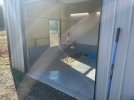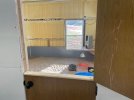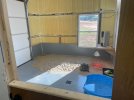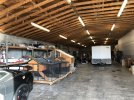I haven't been on here in a LONG time. I just finished my aldabra's room and I figured I'd share. Smedley is three years old and is officially too big to be inside the house this coming winter. I build him a room inside my shop. 2x4 insulated stud walls, with two feet of epoxy shielded plywood at the bottom, epoxy shielded floor with drain. The room is about 14x12 and will last him until we move in a few years. He has an 8x8 insulated overhead door that leads into his outside area. I plan on putting some plants in there also, as well as adding more sand.
You are using an out of date browser. It may not display this or other websites correctly.
You should upgrade or use an alternative browser.
You should upgrade or use an alternative browser.
Finally finished my aldabra's new home.
- Thread starter Cameron
- Start date
That is pretty cool, but the sand is eventually going to cause an impaction. I'd use something else.
Also, that heat lamp is going to "slow-burn" the top of the carapace. Heat lamps aren't effective for larger tortoises.
That is a gorgeous tortoise and I'd hate for you to have to learn either of these lessons the hard way.
Also, that heat lamp is going to "slow-burn" the top of the carapace. Heat lamps aren't effective for larger tortoises.
That is a gorgeous tortoise and I'd hate for you to have to learn either of these lessons the hard way.
I love your tortoise room and it is a nice start on what I would build for a large tortoise in your area.
I agree with what @Tom has said, but will give more background...
I know @ALDABRAMAN uses sand in his night house/barn. However, that is a true night house. The tortoises never eat in there as in SW Florida they always go outdoors in a nice grass area to graze and be fed. Your indoor enclosure will have to serve as indeed an enclosure where they will need to eat and drink protected from the cold winter times of Oklahoma. A very different situation and certainly a bark or mulch substrate would be a better choice there.
You will have a constant heat sink with the floor, unless you did insulate under the slab when the floor was poured. Although we can overcome this with "room temperature" tortoises live on the floor and they are 'designed' to absorb a great deal of what keeps their temperature more moderate from the floor/ground. However, your ground temperatures in Oklahoma will be in the 48° range while in SW Florida, ground temperatures are in the 73° range. Much of the body temperature of a tortoise is influenced by that ground temperature, not as much the room temperature. With basking lights they are attempting to raise their body temperature. Again, in an indoor situation, raising it to daytime metabolic temperatures, not overnight sustenance. The heat from above is loosing ground to the cool floor/ground temp below. So they park there - too long as their core body temperature is still too cool. Tortoises do not feel carapace or even plaston temperatures well. They react to overall core body temperature. A tortoise will walk right up to a bonfire and have to be pulled away or get burned! So a tortoise with cool core body temperature will remain under basking lights and actually slow-burn the carapace.
If I were building an indoor enclosure for a large tortoise in a colder winter climate area I would have well insulated floors. Perhaps building an insulated floor on top of the slab, or installing in-floor heating on top of the slab to keep the floor at 75° or so. I would put up a bank of basking lights. An array of lights spaced perhaps 18" apart and hung about 4 ft high to give a wide basking area of appropriate temperature.
I agree with what @Tom has said, but will give more background...
I know @ALDABRAMAN uses sand in his night house/barn. However, that is a true night house. The tortoises never eat in there as in SW Florida they always go outdoors in a nice grass area to graze and be fed. Your indoor enclosure will have to serve as indeed an enclosure where they will need to eat and drink protected from the cold winter times of Oklahoma. A very different situation and certainly a bark or mulch substrate would be a better choice there.
You will have a constant heat sink with the floor, unless you did insulate under the slab when the floor was poured. Although we can overcome this with "room temperature" tortoises live on the floor and they are 'designed' to absorb a great deal of what keeps their temperature more moderate from the floor/ground. However, your ground temperatures in Oklahoma will be in the 48° range while in SW Florida, ground temperatures are in the 73° range. Much of the body temperature of a tortoise is influenced by that ground temperature, not as much the room temperature. With basking lights they are attempting to raise their body temperature. Again, in an indoor situation, raising it to daytime metabolic temperatures, not overnight sustenance. The heat from above is loosing ground to the cool floor/ground temp below. So they park there - too long as their core body temperature is still too cool. Tortoises do not feel carapace or even plaston temperatures well. They react to overall core body temperature. A tortoise will walk right up to a bonfire and have to be pulled away or get burned! So a tortoise with cool core body temperature will remain under basking lights and actually slow-burn the carapace.
If I were building an indoor enclosure for a large tortoise in a colder winter climate area I would have well insulated floors. Perhaps building an insulated floor on top of the slab, or installing in-floor heating on top of the slab to keep the floor at 75° or so. I would put up a bank of basking lights. An array of lights spaced perhaps 18" apart and hung about 4 ft high to give a wide basking area of appropriate temperature.
I love it!!
The walls are insulated with a spray-on foam insulation.
Thank you Mark.I love your tortoise room and it is a nice start on what I would build for a large tortoise in your area.
I agree with what @Tom has said, but will give more background...
I know @ALDABRAMAN uses sand in his night house/barn. However, that is a true night house. The tortoises never eat in there as in SW Florida they always go outdoors in a nice grass area to graze and be fed. Your indoor enclosure will have to serve as indeed an enclosure where they will need to eat and drink protected from the cold winter times of Oklahoma. A very different situation and certainly a bark or mulch substrate would be a better choice there.
You will have a constant heat sink with the floor, unless you did insulate under the slab when the floor was poured. Although we can overcome this with "room temperature" tortoises live on the floor and they are 'designed' to absorb a great deal of what keeps their temperature more moderate from the floor/ground. However, your ground temperatures in Oklahoma will be in the 48° range while in SW Florida, ground temperatures are in the 73° range. Much of the body temperature of a tortoise is influenced by that ground temperature, not as much the room temperature. With basking lights they are attempting to raise their body temperature. Again, in an indoor situation, raising it to daytime metabolic temperatures, not overnight sustenance. The heat from above is loosing ground to the cool floor/ground temp below. So they park there - too long as their core body temperature is still too cool. Tortoises do not feel carapace or even plaston temperatures well. They react to overall core body temperature. A tortoise will walk right up to a bonfire and have to be pulled away or get burned! So a tortoise with cool core body temperature will remain under basking lights and actually slow-burn the carapace.
If I were building an indoor enclosure for a large tortoise in a colder winter climate area I would have well insulated floors. Perhaps building an insulated floor on top of the slab, or installing in-floor heating on top of the slab to keep the floor at 75° or so. I would put up a bank of basking lights. An array of lights spaced perhaps 18" apart and hung about 4 ft high to give a wide basking area of appropriate temperature.
Another added factor about the sand is locomotion. In a large outdoor enclosure the tortoise would walk a long way every day. This locomotion assists gut motility and helps to reduce the chance of sand impaction due to any incidental sand intake. In a relatively small, by comparison, indoor enclosure, that sand becomes a deadly hazard.
Do you know what type of sand it is? I would be concerned about his eyes if the sand had sharp edges like silica or quartz sand. We have sand in our Aldabra night box but we specifically chose very fine oolitic sand. They like to dig down into it a little bit at night and they inevitably get it in their eyes. It doesn't seem to bother them but I feel bad when I see it so I try to rinse it out every morning.
Thanks for the info. That’s why I posted pics of it, I’m always willing to learn and do what’s best for my tortoise. I’ll ditch the heat lamp and get cypress mulch for substrate.That is pretty cool, but the sand is eventually going to cause an impaction. I'd use something else.
Also, that heat lamp is going to "slow-burn" the top of the carapace. Heat lamps aren't effective for larger tortoises.
That is a gorgeous tortoise and I'd hate for you to have to learn either of these lessons the hard way.
Thanks for all the detailed info. My idea for sand came from Aldabraman’s night house like you had mentioned. I’ll add cypress mulch and ditch the sand.I love your tortoise room and it is a nice start on what I would build for a large tortoise in your area.
I agree with what @Tom has said, but will give more background...
I know @ALDABRAMAN uses sand in his night house/barn. However, that is a true night house. The tortoises never eat in there as in SW Florida they always go outdoors in a nice grass area to graze and be fed. Your indoor enclosure will have to serve as indeed an enclosure where they will need to eat and drink protected from the cold winter times of Oklahoma. A very different situation and certainly a bark or mulch substrate would be a better choice there.
You will have a constant heat sink with the floor, unless you did insulate under the slab when the floor was poured. Although we can overcome this with "room temperature" tortoises live on the floor and they are 'designed' to absorb a great deal of what keeps their temperature more moderate from the floor/ground. However, your ground temperatures in Oklahoma will be in the 48° range while in SW Florida, ground temperatures are in the 73° range. Much of the body temperature of a tortoise is influenced by that ground temperature, not as much the room temperature. With basking lights they are attempting to raise their body temperature. Again, in an indoor situation, raising it to daytime metabolic temperatures, not overnight sustenance. The heat from above is loosing ground to the cool floor/ground temp below. So they park there - too long as their core body temperature is still too cool. Tortoises do not feel carapace or even plaston temperatures well. They react to overall core body temperature. A tortoise will walk right up to a bonfire and have to be pulled away or get burned! So a tortoise with cool core body temperature will remain under basking lights and actually slow-burn the carapace.
If I were building an indoor enclosure for a large tortoise in a colder winter climate area I would have well insulated floors. Perhaps building an insulated floor on top of the slab, or installing in-floor heating on top of the slab to keep the floor at 75° or so. I would put up a bank of basking lights. An array of lights spaced perhaps 18" apart and hung about 4 ft high to give a wide basking area of appropriate temperature.
I like your idea of the array of lights and I’ll get working on that.
Please keep us posted on how this works out for you through the long cold winter. All keepers of large tortoises can learn from your excellent example, and from whatever transpires with temperature maintenance over winter. Thanks for posting this for us!Thanks for the info. That’s why I posted pics of it, I’m always willing to learn and do what’s best for my tortoise. I’ll ditch the heat lamp and get cypress mulch for substrate.
I will. I’m gonna try and make more of an effort to be on here more.Please keep us posted on how this works out for you through the long cold winter. All keepers of large tortoises can learn from your excellent example, and from whatever transpires with temperature maintenance over winter. Thanks for posting this for us!
Similar threads
- Replies
- 12
- Views
- 3K
- Replies
- 9
- Views
- 1K






